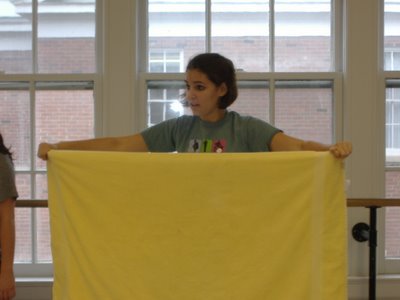Two arts are better than one
Arts therapies are no different. While each can be successful on its own, participants can have multiple different experiences by taking part in more than one type of arts therapy. Haley and I wanted the ATCO participants to be able to take advantage of this variety. We asked Anna, a theater student interested in drama therapy, to be a guest teacher.
What is drama therapy?
The National Association for Drama Therapy defines drama therapy as “the systematic and intentional use of drama/theatre processes and products to achieve the therapeutic goals of symptom relief, emotional and physical integration, and personal growth.” Its goal include helping clients to “tell [their stories], solve problems, set goals, express feelings appropriately, achieve catharsis, extend the depth and breadth of inner experience, improve interpersonal skills and relationships, and strengthen the ability to perform personal life roles while increasing flexibility between roles.”
It’s easy to see that drama therapy has similar goals to dance therapy. It simply uses a different art form to tackle the same objectives.
Drama in action
Anna, who had already been working with our group for several weeks, decided to focus on developing the participants’ personal growth by encouraging creative thinking through miming and props. She worked to break down “functional fixedness,” a mental barrier that prevents people from easily forming new ideas with existing data. The example she used was only being able to see an object as useful for what its “traditional” uses. Her activities were designed to overcome this barrier and encourage imagination.
The following pictures (which I took during the class) and text illustrate the activities during the class.
The first prop Anna (below) introduced was a blanket.

ATCO participant Chase (left) and most of the other participants first thought the blanket could be best used as a cape.

ATCO participant Rex (below) found other uses for the blanket. He cradled it as a baby (top) and wore it as a veil (bottom).


The second prop Anna introduced was a pillow.
Rex (left) and Anna (right) pet the pillow, imagining it was a cat, while volunteers Morgan and Janelle and ATCO participant Irene (left to right) look on from behind.

Using great creative thought and superb balancing skills, Irene turned the pillow into a hat.

Music therapy student Amy (top) and Chase (bottom) both used the pillow to become “pregnant.”


Rex used the slit in the pillow case to turn it into an oven mitt.

The class ended on with a high-spirited game as the pillow became a soccer ball.


0 Comments:
Post a Comment
<< Home